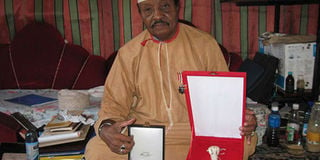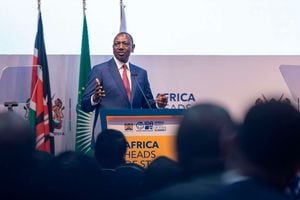Kiswahili is an international language and native speakers must live with this reality

Ahmed Sheikh Nabhany. He called on the Kenya National Examination Council to consider setting Kiswahili exams in each of the 15 or so dialects. PHOTO | FILE | NATION MEDIA GROUP
What you need to know:
- Mzee Nabhany was also very uncomfortable with the rate at which the Kiswahili language was borrowing words from other languages.
- Most non-native Waswahili, who engage themselves on matters of Kiswahili, have realised that Kiswahili is a great resource just like oil and forests.
In his tribute to the fallen Siku Njema author Ken Walibora (Saturday Nation, May 2, 2020), Prof Evan Mwangi raised salient concerns that ought to attract the attention of the government, policymakers and Kiswahili scholars.
Prof Mwangi lamented that through colonialism and post-independence, ethnic Swahili speakers have been pushed far from the centre of their own language and institutions.
He claimed that people who are non-native Swahilis are benefiting more from Kiswahili locally and abroad than the ethnic Kiswahili speakers.
He also said that if the trend continues unabated, there is a high possibility that the few remaining native Swahili scholars in the academy today will all be gradually replaced by the likes of Ustadh Mwangi al-Murang’a.
The writer further stated that the Kenyan education system disadvantages native Swahili students because of regional inequalities.
The students, he argued, have also “uprooted Swahili language from its quotidian usage by ordinary people in favour of some spurious pure ‘sanifu’ dialect put in place by European missionaries a long time ago”.
The aim of this article is not to engage Prof Mwangi and his dog — Sigmund — in polemics, but rather to throw some more light on the issues he raised.
His observations take us back into an array of debates of the past. Who is a Mswahili, for example?
LANGUAGE ENRICHED
There are four categories of Waswahili. The first comprises the Wangozi — who are the ‘original’ or native Waswahili.
Within this category we have sub-tribes (dialects) - such as Wa-Amu, Wa-Pate, Wa-Aunya, Wa-Siu, Wa-Mtang’ata, Wa-Kilindi, Wa-Jomvu and Wa-Vanga.
In Tanzania, we have Wa-Mafia, Wa-Mrima, Wa-Tumbatu and Wa-Unguja (Zanzibar Island). Kiunguja, spoken in Zanzibar, was selected by missionaries to be the basis of standardising Kiswahili.
The second category are those born from mixed marriages between Arabs and native Swahili — and are light-skinned. The third are people from other African tribes.
These are people who lived with the native Waswahili and imbibed Swahili culture and were eventually assimilated.
The fourth are people who study Kiswahili language and culture as a discipline — and I think Ken Walibora belonged to this category.
Due to contact with Arabs, the Kiswahili language is associated with some teachings of Islam. Islam was brought to East Africa by Arabs, who used Arabic to spread it.
Indeed, the contact between native Waswahili and Arabs contributed greatly in expanding the Kiswahili lexicon.
Sixty per cent of the total Kiswahili vocabulary count is Bantu, 30 per cent is Arabic and 10 per cent is from other languages - such as English, Portuguese, Chinese and even Gikuyu.
RADICAL APPROACH
Mzee Ahmed Sheikh Nabhany of Mombasa, a native Mswahili who died in 2017, was a leading advocate for a ‘going-back-to-the-roots approach’ in order to enrich the Kiswahili lexicon.
He argued that original Kiswahili/Kingozi words could be used in place of those of Arabic origin that got their way into modern Kiswahili.
Such words include zeo/mwiya (time/muda), mkwasi (rich person/tajiri), bombobombo (cold/baridi), et cetera.
His hypothesis was that there is an original Kiswahili word for every Arabic loan word. He later propounded these thoughts in his book, Kandi ya Kiswahili (AERA, 2012).
Mzee Nabhany was also very uncomfortable with the rate at which the Kiswahili language was borrowing words from other languages — particularly due to the explosion of science and technology.
In order to counter this, he, together with other lexicologists, such as professors Rocha Chimerah and Kyallo Wadi Wamitila, recommended that scientific and technological terms be translated or interpreted from a given donor language.
Through this approach, he brought on board modern Swahili terminologies, such as chakucha (chakula cha kucha) for ‘breakfast’, chakushindia (lunch) and chakulaza (supper).
Perhaps the most accepted words in modern Swahili that the scholar coined are runinga (television), ngamizi (computer) and mwengoya (radio).
SETTING EXAMS
I agree with Prof Mwangi’s observation that students from the Coast perform poorly in exams set in standard Kiswahili.
In 2008, for example, when the Kenya Certificate of Secondary Education (KCSE) exam results were announced, candidates from the Coast had performed dismally compared to their counterparts in other parts of the country — more often referred to as ‘wabara’.
Mzee Nabhany called on the Kenya National Examination Council (Knec) to consider setting Kiswahili exams in each of the 15 or so dialects.
His argument was that candidates from the Coast — a majority of whom speak various Kiswahili dialects — were being ‘short-changed’ in sitting an exam that was set in standardised Kiswahili, or Kiswahili sanifu.
This argument is in tandem with Prof Mwangi’s view. However, it may not be tenable to set 15 exams (in each dialect) because of the cost implications of developing the 15 or so dialects that make up Kiswahili, let alone teaching them.
The more than 15 dialects are instead used as databanks in enriching standard Kiswahili (Kisanifu).
Prof Mwangi also insinuated that ‘upcountry’ Kiswahili scholars and writers are doing more exploits with Kiswahili compared with ‘native speakers’. This is also true.
However, Kiswahili, as an academic discipline, has attracted even scholars from other continents.
LUCRATIVE RESOURCE
In the early 2000s, Mzee Nabhany warned that East Africa could easily ‘lose Kiswahili’ to the West — which is exploiting the Kiswahili language more compared to East Africa, where it is taken for granted. More than 100 universities in the United States teach Kiswahili.
Most non-native Waswahili, who engage themselves on matters of Kiswahili, have realised that Kiswahili is a great resource just like oil and forests.
The Chinese, for example, are using Kiswahili to help them market their products in Eastern and Central Africa. Microsoft has also incorporated Kiswahili in its system to tap the market in this part of the world.
With the advent of devolution, I am sure the problem of regional inequalities and the disadvantaging of native Swahili students is going to be addressed in one way or the other — but not by re-standardising Kiswahili.
Kiswahili sanifu (Kisanifu) is here to stay — and the coastal natives have to live with this reality.
Mombasa County and the coastal region in particular has to find a way of commoditising Kiswahili and use the language as an income earner — the way ‘wabara’ scholars are doing.
Kiswahili is now a global language and it is foolhardy to continue thinking that it belongs to Wapwani.
Enock Matundura is the translator of Barbara Kimenye’s Moses Series (Oxford University Press) and teaches Kiswahili literature at Chuka University; [email protected]




